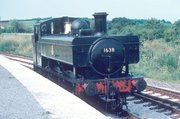Tank locomotive
|
|
A tank locomotive (occasionally tank engine) is a steam locomotive that carries its own fuel and water with it, instead of pulling it behind it in a tender.
| Contents |
Types of tank
There are a number of sub-classes of tank locomotive, mostly based on the location and style of the water tanks. These include the side tank, the saddle tank, the pannier tank, the well tank and others.
Side tank
Brsince78_side_tank_2575.jpg
The water is contained in two somewhat rectangular tanks mounted on each side of the locomotive, next to the boiler. This is the most common configuration. The side tanks restrict access to the motion.
Saddle tank
Brsince78_saddletank_1332.jpg
The water tank surrounds the boiler on both sides and above, like a "saddle" atop the boiler. Generally the tank is curved in cross-section, like an inverted 'U'. This was fairly popular especially in smaller locomotives, and especially in industrial use. It gave a greater water supply, but restricted the maximum size of the boiler and restricted access to it for cleaning. The water is pre-heated by the boiler, but the locomotive has a higher centre of gravity and hence must operate at lower speeds.
Pannier tank
This variety of tank, almost exclusively used by the British Great Western Railway, consisted of box-shaped tanks attached to the sides of the boiler. Unlike the side tank, they did not go all the way down and there was space between the tank and the footplate. This reduced the centre of gravity whilst allowing access to the motion.
Well tank
Brsince78_well_tank_1114.jpg
In this design, commonly used in earlier and smaller locomotives, the water is stored in a 'well' on the underside of the locomotive, generally between the locomotive's frames. This does not restrict access to the boiler, but space is limited there and this is not suited to locomotives that need a good usable range before refilling.
Pros and cons
The benefits of this idea include:
- Bi-directionality: a tank locomotive is pretty much as capable running 'backwards' as 'forwards'. A locomotive that hauls its fuel and water behind it in a tender is unable to do this, because the heavy tender is not designed to be pushed and may become unstable at speed. Tender-hauling locomotives are generally much more limited in speed when running tender first. Therefore, operation using such locomotives generally require turning facilities at each end of the run, such as a turntable or wye. A tank locomotive, on the other hand, can simply run around the train and pull it back in the other direction.
- Fuel and water add to adhesive weight: the usable tractive abilities of a locomotive are simply expressible as a product of the weight on drivers multiplied by the factor of adhesion. Therefore, up to the limits of the maximum permissible axle loading, and other loading limits, the more weight one can put upon the driving wheels the better. A tank locomotive gets the benefit of the weight of its own fuel and water being available for use in this manner.
- Compactness: A tank locomotive is practically always shorter than the equivalent locomotive plus tender. In space restricted environments, this is important.
- Efficiency. Water in the tanks is heated by the boiler and so is warmer when it is injected into the boiler.
There are, of course, corresponding disadvantages:
- Limited fuel and water capacity: a tender can contain far more of both than can the spare space on a locomotive.
- Varying adhesive weight: Use of the fuel and water for the purposes of adhesive weight means that the available traction of the locomotive decreases as they are used up.
- Axle loading limits a problem: for larger tank locomotives, it's hard to put much fuel and water aboard without requiring way more pairs of wheels than one should have on a rigid frame. A locomotive can indeed grow too large to be feasible as a tank locomotive.
Popularity
Worldwide, tank locomotives varied in popularity. They were more common in areas where space was at a premium, mostly Europe and other areas where the railways came later and had to fit into the towns rather than the towns growing around the rails. With their limited fuel and water capacity, they were not favored in areas where long runs between stops were the norm.
They were very common in the United Kingdom, France, and in particular Germany, where some attained quite prodigous size. In the United States they tended to be restricted to push-pull suburban service, always the tank engine's forté, and also for switching service in terminals and locomotive shops. They were also very popular in logging, mining and industrial service.
Tank locomotives in fiction
The most famous tank locomotive, of course, is the fictional Thomas the Tank Engine, who was actually based on a London, Brighton and South Coast Railway class E2 0-6-0 side tank.de:Tenderlokomotive pl:tendrzak

